Cichlids make up one of the most diverse fish groups on the planet.
Scientists estimate between 2000-5000 different species exist (crazy, right?), though only around 1800 currently have descriptions.
They hail from Africa, South and Central America, and even Asia.

While cichlids differ, they all share one common feature: pharyngeal jaws. The bottom pharyngeal bone fused into a single tooth-bearing structure manipulated by strong muscles to function as a second set of jaws.
Cichlids are “secondary freshwater” fish. This means they evolved from marine fish such as wrasses, parrotfish, damselfish, and surfperches.
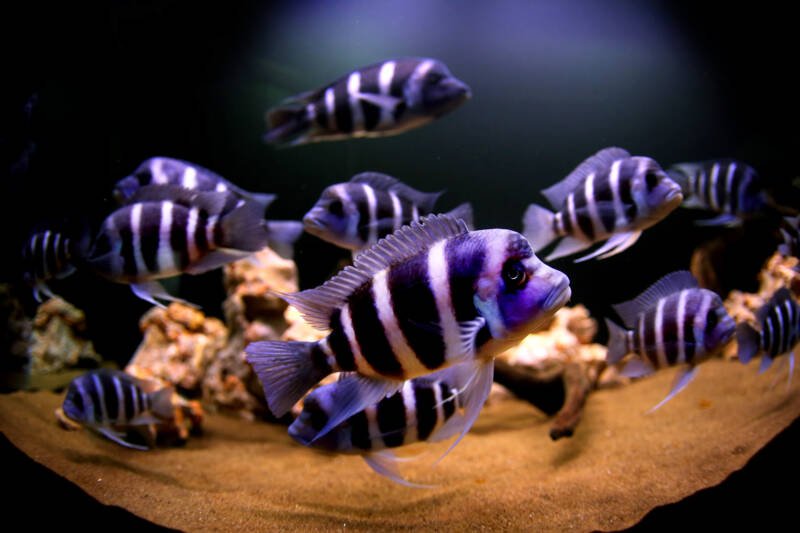
With such diverse ancestors, it’s no wonder cichlids vary so much in color, shape, and personality.
In this article
Cichlid Care
Cichlids vary in their needs, and you should research your desired species before bringing them home. However, there are some generalities to the Cichlidae family you can count on.
Whether you opt for African or New World cichlids, similarities emerge.
Cichlids like to dig in the substrate. As such, under gravel filters are a poor choice.
You also want to choose a grain size safe enough to keep your little excavators happy. Monitor the tank for bare patches and make appropriate repairs.
The majority of cichlids lean toward omnivorous habits. As such, they’ll nibble on your plant life.
Unless you want to replace your greenery frequently, use hardy species in your aquarium:
- Amazon sword
- Anubias or anubias nana
- Java fern.
Make sure you keep the other end of that omnivore habit in mind when choosing tank mates.
Avoid any fish small enough to become a snack. Even the most peaceful cichlids could decide to munch on tiny tank mates.
African Cichlids

Scientists estimate around 1300 species of African cichlids. All of them hail from just three lakes in east Africa: Lake Malawi, Lake Victoria, and Lake Tanganyika.
The most popular aquarium species come from Lake Malawi as they’re the most colorful.
African cichlids are robust, making them ideal choices for beginning aquarists. Odds are they’ll handle any accidental mistakes you might make (this isn’t permission, by the way).
They’re also social and vibrant, enlivening any aquarium.
You WILL need to spend a little more for these fish than most tropical species. The larger or more colorful the option, the higher the price.
If you want to save, opt for a juvenile, and wait a few months for the colors to come in.
1. African Peacock Cichlid (Aulonocara spp.)
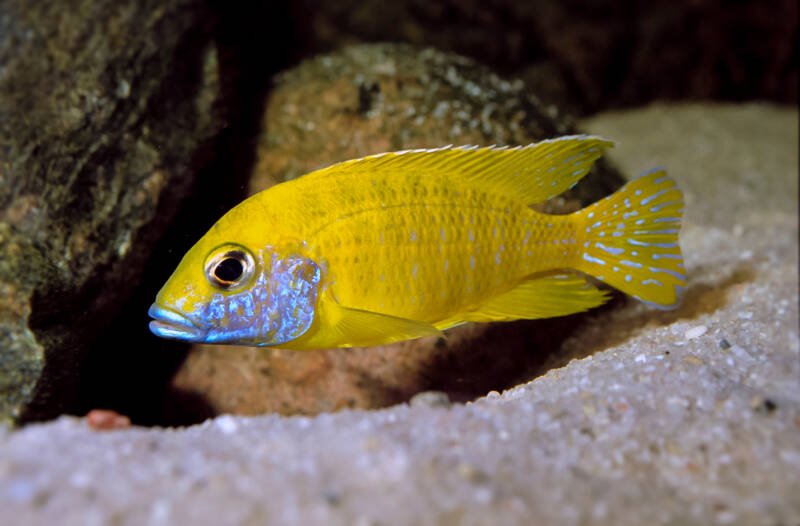
- Difficulty: Easy
- Temperament: Semi-Aggressive
- Diet: Omnivore with a preference for meat
- Tank Size: 55 gal (208 l) for single, 75 gal (284 l) for group
There are 22 species of peacock cichlids, all hailing from Lake Malawi. They get their name from the brilliant colors they display, reminiscent of a peacock’s tail.
Also, like peacocks, the males have bright colors, while females are drab.
These cichlids are easy for both beginners and accomplished aquarists. They prefer a lot of open space for swimming, but they also need caves for hiding, sleeping, and breeding.
If you don’t keep up with water conditions (especially ammonia), they WILL deteriorate.
They ARE omnivores, but they gravitate toward the meatier end of the spectrum.
Not the cleanest eaters in the world, you need to stay on top of your tank water changes and substrate vacuuming to keep up with the extra bioload.
2. Kribensis (Pelvicachromis pulcher)

- Difficulty: Easy
- Temperament: Peaceful
- Diet: Omnivore with a preference for meat
- Tank Size: 20 gal (76 l) for a pair, larger for group
Kribensis is a small, colorful cichlid, tolerant of community tanks.
Males grow larger than females and have more pointed fins. When breeding, females develop a purple or red rounded belly.
So long as their water conditions stay stable, kribs remain undemanding for everyone to care for.
Similar to the peacock cichlid, they lean toward the meaty side of the omnivore palate. You’ll need to watch your ammonia levels as a result.
They get along well with characins, barbs, danios, and rasboras, adding a great splash of color to your tank.
They also tolerate gouramis, corydoras, and plecostomus catfish without a problem. Just watch them during the breeding season.
3. Electric Blue Cichlid/Electric Blue Hap (Sciaenochromis fryeri)
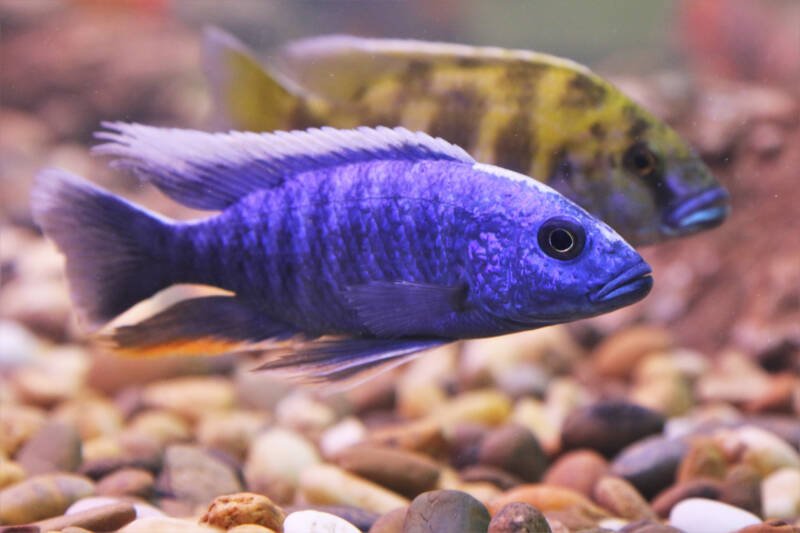
- Difficulty: Easy
- Temperament: Semi-Aggressive
- Diet: Omnivore with a preference for fish
- Tank Size: 55 gal (208 l) and at least 5′ (152 cm) long
Electric blue haps resemble their name (at least the males): you can’t miss those brilliant blue scales. Females wear striking silver, and they can develop a subdued blue shading when they’re mature.
Your tank needs to keep a basic pH, with hard water, and plenty of rocks.
Stocking is very important, especially if you want to breed your haps: three females per male prevents stress during the mating season.
These fish are mouthbrooders, which is always fun to watch.
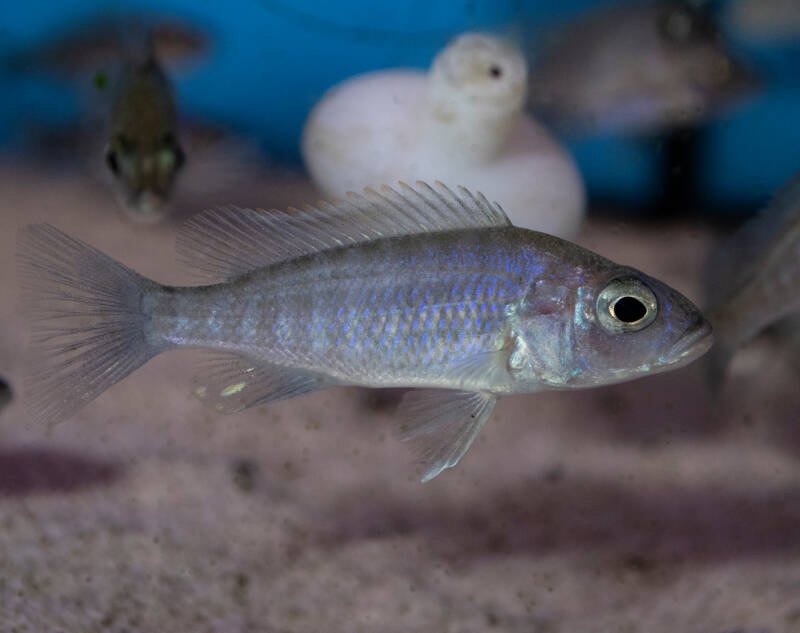
Electric blue haps have a preference for fish, and they will eat smaller tank mates without hesitation.
Most other Malawi cichlids are safe, but NOT African peacocks. Male blue haps kill male peacocks and mate with the females, resulting in hybrids. (Oops!)
4. Frontosa Cichlid/Humphead Cichlid (Cyphotilapia frontosa)
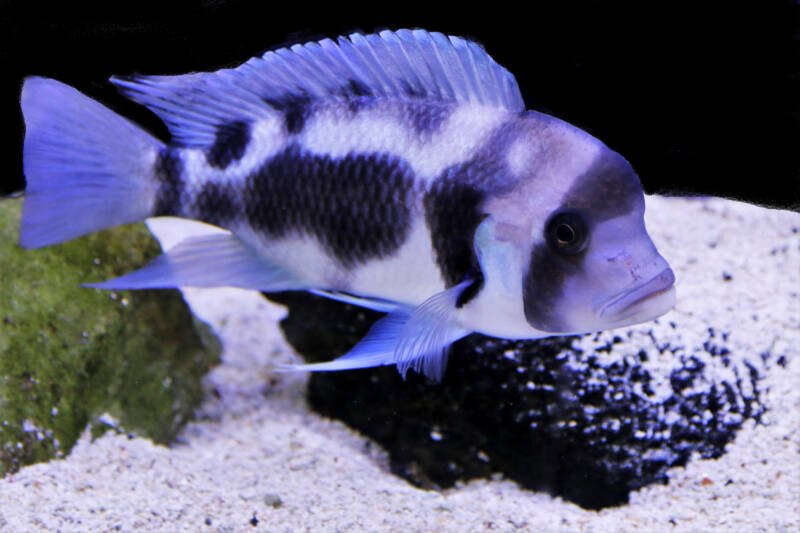
- Difficulty: Moderate
- Temperament: Semi-Aggressive
- Diet: Carnivore
- Tank Size: 75 gal (284 l) for ONE
One of the larger cichlids to come from Lake Tanganyika, frontosas have a distinct appearance.
The prominent curve to their foreheads (even more distinct in males) consists of fat deposits. As the fish age, the “hump” grows with them.
Frontosas present a challenge to aquarists – and not due to their size. Lake Tanganyika provides an oxygen-rich environment. You’ll need to replicate that with multiple air stones to keep your frontosa healthy.
At the same time, you need a strong canister filter for all of their waste.
While not the most aggressive cichlids, frontosas ARE active predators. One of their favorite meals are the Cyprichromis spp. cichlids.
They lie in wait for these smaller fish. If you’re not careful, your frontosas will happily snack on the other fish in a community tank.
5. Jewel Cichlid (Hemichromis spp.)

- Difficulty: Easy
- Temperament: Semi-Aggressive
- Diet: Omnivore
- Tank Size: 30 gal (113 l) at least
Jewel cichlids live up to their name: they’re some of the most stunning fish you can find. With 11 species to choose from, you’re sure to find a pattern of colors you’ll want to add to your aquarium.
True to cichlid’s reputation, jewels like to dig, so provide them with a sandy substrate that won’t injure them in their excavations.
They’re also HIGHLY territorial, so break up their sightlines with decorations and rocks to prevent excessive aggression toward tank mates.
If you want to get the most out of your jewel cichlid’s color, keep the diet as varied as possible. They’ll honestly take everything you offer them (they’re not picky).
Just be careful if you have other fish with flowing fins – jewels are known to nip.
New World Cichlids
In comparison to African cichlids, New World cichlids make up around 570 species.
These include fish found in South America, Central America, and a lone species from the United States (the Texas Cichlid).
You’ll find a lot of variation in size in the New World, including several species of dwarf cichlid.
The smallest checks in at just 1 inch (3 cm) in length, while the largest tops out at close to 2 feet (60cm). When choosing your cichlid, plan tank size accordingly.
Central American cichlids, in particular, display territoriality and predatory instincts.
They also grow FAST. While juveniles do fine in smaller tanks, have a larger aquarium cycled and ready to go for when it’s time to move these cichlids over.
6. Bolivian Ram (Mikrogeophagus altispinosus)
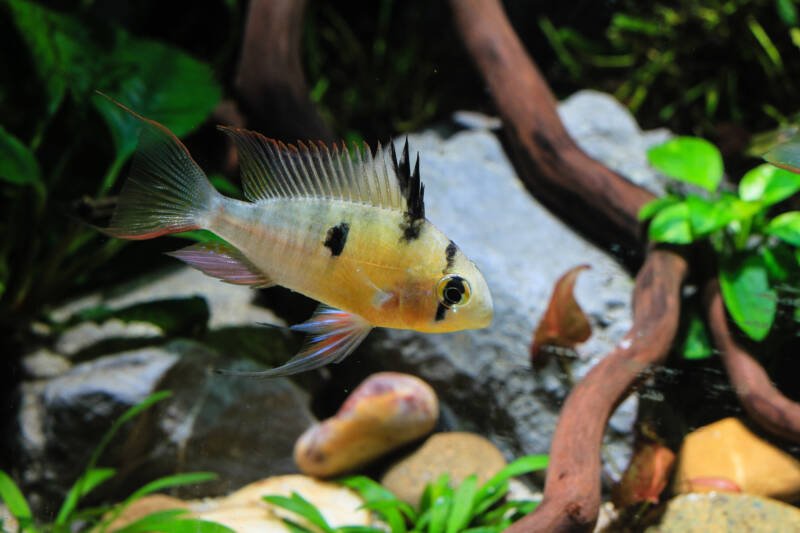
- Difficulty: Easy
- Temperament: Peaceful
- Diet: Omnivore
- Tank Size: 20 gal (76 l)
Bolivian rams are members of the dwarf cichlid group. At just around 3.5 inches (9 cm), they don’t need much space.
They’re a light bluish-brown with orange or red along the fins and tail, a black spot in the center, and a black crescent through the eye.
Bolivian rams prefer open spaces for swimming but don’t neglect plenty of hiding places. After all, when placed on the cichlid scale of aggression, they’re at the bottom.
Keep up with proper water quality, and they’ll stay happy and healthy.
Aquarists love these little fish for their big personalities. This includes the brightly patterned German ram (Mikrogeophagus ramirezi).
Rams learn to greet you at mealtimes, just as dogs might.
With no preferences in their diet, they’re a cinch to feed. Just don’t skimp on the variety!
7. Angelfish (Pterophyllum scalare)
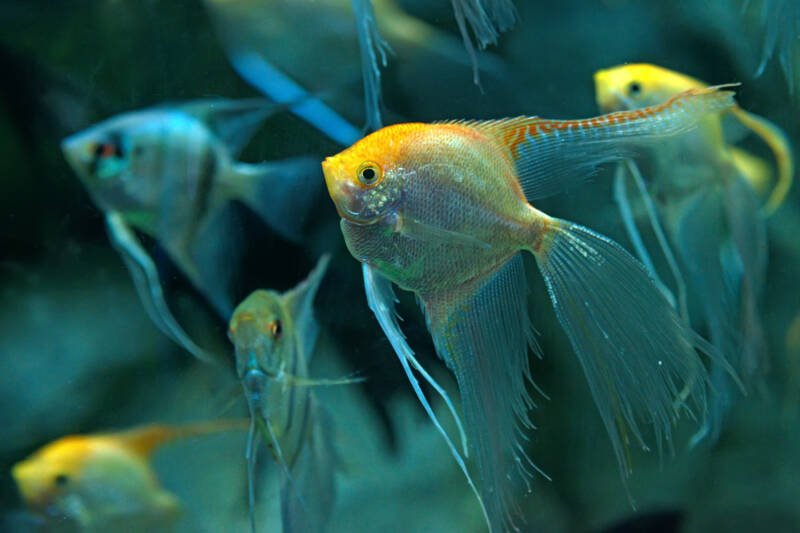
- Difficulty: Moderate
- Temperament: Aggressive
- Diet: Omnivore
- Tank Size: 30 gal (113 l) for single, 55 gal (208 l) for a pair
Who doesn’t recognize the iconic angelfish? They get their name for the marine angelfish, despite bearing ZERO resemblance.
Instead, they have a flattened diamond shape accented with long dorsal and anal fins. Almost entirely captive-bred, the colors are endless.
Angelfish are EXTREMELY sensitive to water conditions. You have to monitor the water quality closely to avoid problems.
Their trailing fins pose a temptation to other fish, too, so watch your angels in community tanks.
As beautiful as angelfish appear, these cichlids ARE aggressive. They target smaller tank mates.
The older they get, the more territorial they become. On the flip side, they startle easily, panicking at shadows and fast movements. As such, they’re not great for beginners.
8. Apistogramma (Apistogramma spp.)
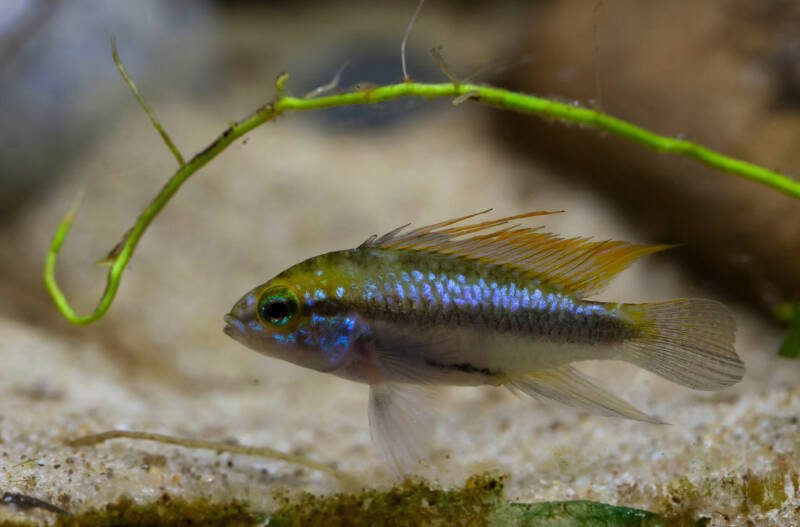
- Difficulty: Easy
- Temperament: Semi-Aggressive
- Diet: Omnivore
- Tank Size: 20 gal (76 l)
Apistogrammas come in a variety of patterns and colors. With close to 90 different species discovered (so far), aquarists get spoiled for choice!
And as members of the dwarf cichlid group, they don’t require large aquariums.
Of course, some of that famous cichlid behavior still lurks inside these colorful South American fish.
They set up territories within their tank, and they won’t hesitate to defend those boundaries from any others, especially during spawning season.
But apistos also have curious personalities. They pay attention to what happens OUTSIDE of the tank, as well inside.
This encourages them to interact with their owners. It’s one of the traits that endear them to aquarists of every level!
9. Discus (Symphysodon spp.)
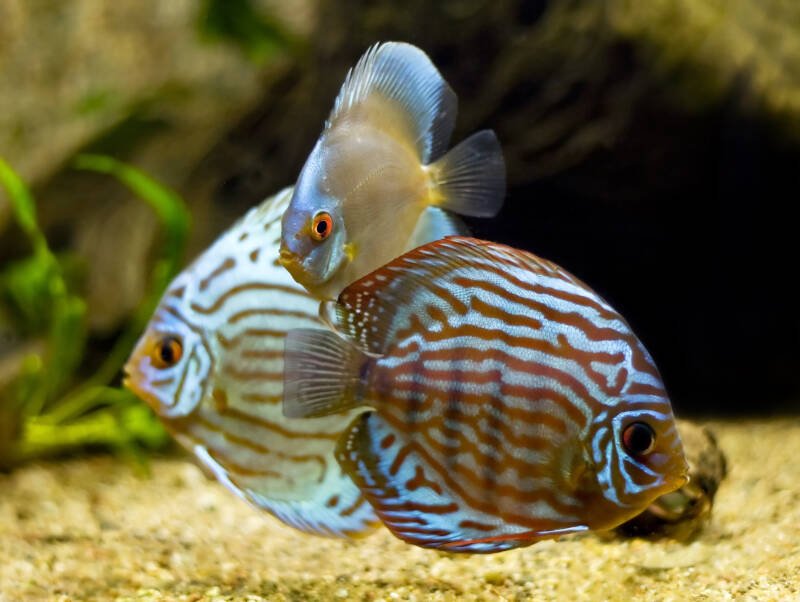
- Difficulty: High
- Temperament: Peaceful
- Diet: Carnivore
- Tank Size: 50 gal (189 l) for single but watch height
Discus have earned the title “King of the Aquarium Fish.” They’re relatively large disc-shaped cichlids (go figure), available in dramatic colors and patterns.
They’re the most compressed cichlids available, even more so than angelfish.
Every aspect of the discus makes it challenging to keep.
They don’t like acclimating to a new tank, they grow large (6-10 inches/15-25 cm), they’re sensitive to water fluctuations, and they’re susceptible to stress-related diseases. Even experienced aquarists struggle with discus.
The carnivorous diet doesn’t make water quality easy to maintain, either. The extra nitrogen load means keeping up with cleaning and filtration.
If you want to tackle keeping discus, make sure you’re at the top of your game.
10. Oscar (Astronotus ocellatus)
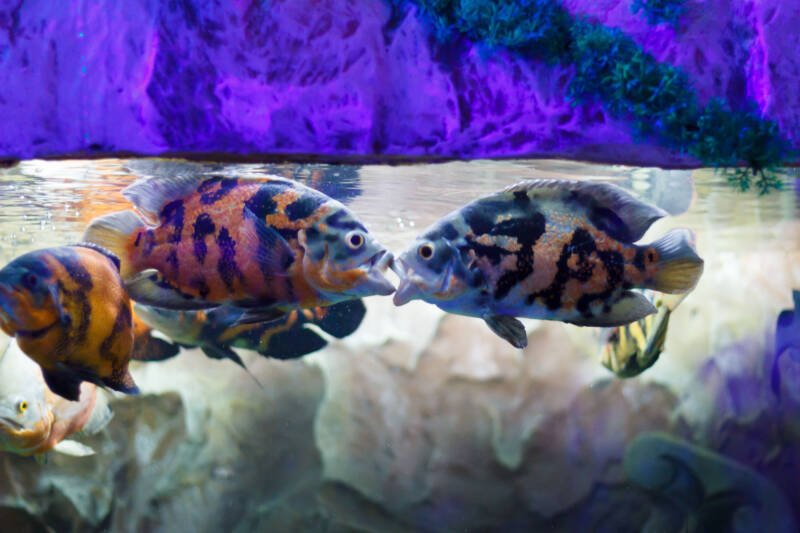
- Difficulty: Easy
- Temperament: Aggressive
- Diet: Carnivore
- Tank Size: 100 gal (379 l)
Oscars may not have the most striking appearance – though the black and orange patterns aren’t too shabby.
However, they make up for their lack of flash with the biggest personalities in the fish world. Can’t get a dog due to allergies? Consider bringing an oscar into your life.
Oscars SURGE with curiosity. Not content with just the tank, they spy on the entire room to see what’s going on.
They’ll follow you around, greet you at the aquarium surface, and even learn tricks. (That’s right, your oscar can learn to roll over!)
Unhappily, Oscars grow FAST. Topping out at around 12 inches (33 cm), they need A LOT of room.
As aggressive carnivores, they don’t play nicely with others, either. That means a large tank all to themselves.
11. Convict Cichlid (Amatitlania nigrofasciata)
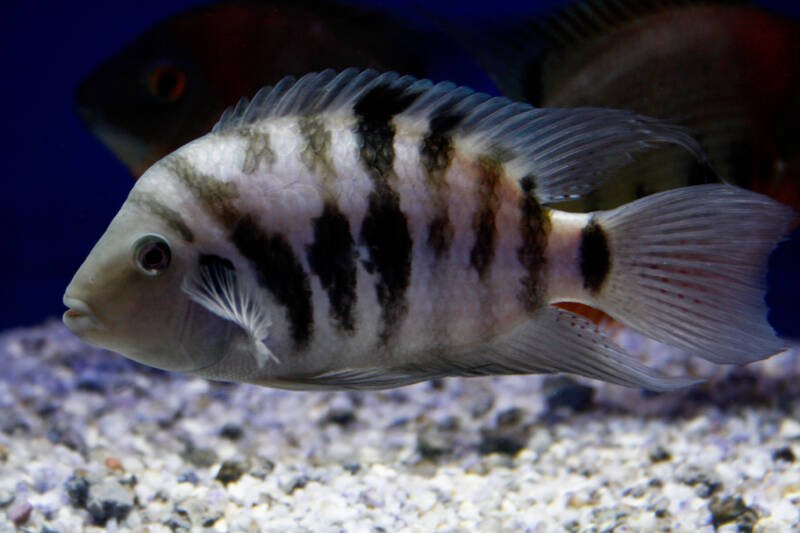
- Difficulty: Easy
- Temperament: Aggressive
- Diet: Omnivore
- Tank Size: 20 gal (76 l) for a pair of smaller fish, but 50 gal (189 l) for adults
Convict cichlids get their name from the bands of black and white down their sides, mimicking stereotypical “jailbirds.”
On the smaller side, they average 5-6 inches (13-15cm) at full size. Males get larger, but (for once) females have a brighter coloration.
Convicts do well with consistent water quality. However, they have a reputation for rearranging the furniture.
Don’t be surprised to find them uprooting your live plants and decorations and moving them around the tank.
Convict cichlids hold the distinction as one of the easiest species for aquarists to breed.
In fact, they don’t need your assistance in the matter. So long as you have a male and female, odds are you’ll end up with baby convicts in the tank.
12. Firemouth Cichlid (Thorichthys meeki)
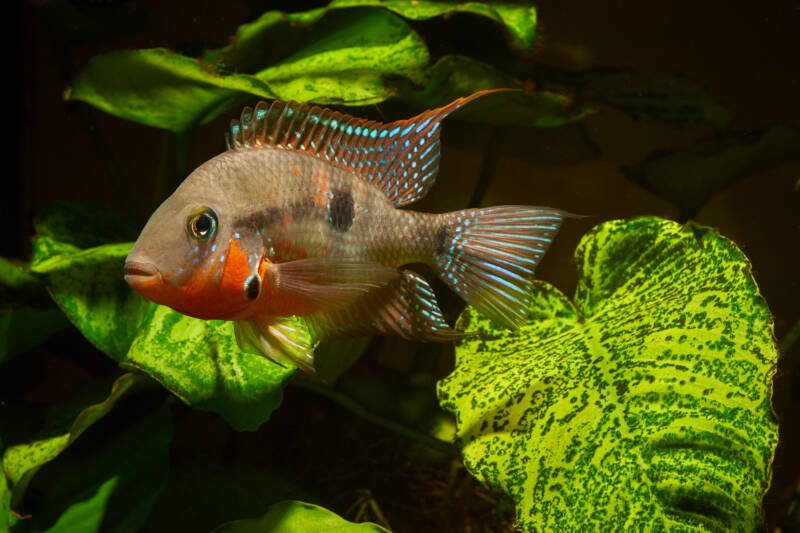
- Difficulty: Moderate
- Temperament: Semi-Aggressive
- Diet: Omnivore
- Tank Size: 30 gal (113 l) for single, 55 gal (208 l) for a pair
Firemouth cichlids aren’t well-received outside of aquarist circles. Endemic to Central America, they’ve since become invasive species around the world.
While these mouthbrooders might make attractive additions to your aquarium, the rest of the world kind of despises them.
Firemouths earn their name for the bright red patterns they display during breeding.
They average 5 inches (12 cm) in length, and they DON’T handle stress well. In the wild, they keep to themselves, though they tolerate each other in captivity.
You need to provide plenty of room for swimming space, as well as proper territory. They tolerate other fish their size, but they’ll bully and attack smaller fish.
During spawning, their aggression goes up, so keep an eye on their tank mates.
13. Flowerhorn cichlid
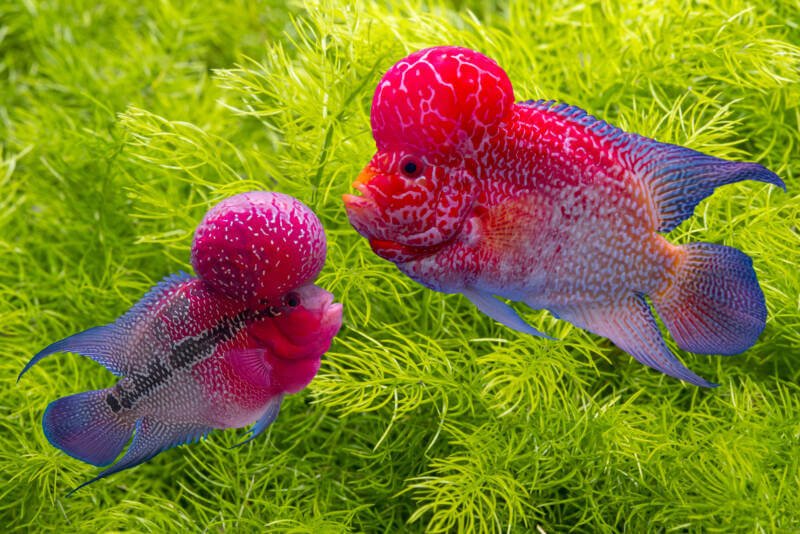
- Difficulty: Moderate
- Temperament: Semi-Aggressive
- Diet: Omnivore
- Tank Size: 75 gal (284 l)
Flowerhorn cichlids are beautifully unique. Mainly because they’re artificial hybrids.
They don’t exist in the wild, but their closest relatives are the South American fish that led to their creation: the blood parrot and the red devil.
The prominent bulge on the heads sets them apart. Aquarists also love the “braided” ends of their dorsal and anal fins.
It creates an iconic silhouette, but it also slows down their swimming speed. You’ll need to keep the outflow on your filters to a minimum.
And while flowerhorns DON’T appreciate hanging out in a crowd, they DO prefer to swim in pairs.
It minimizes their stress levels and prevents excessive aggression. You’ll need to upgrade your tank size to allow enough room for two, though.
14. Jack Dempsey (Rocio octofasciata)
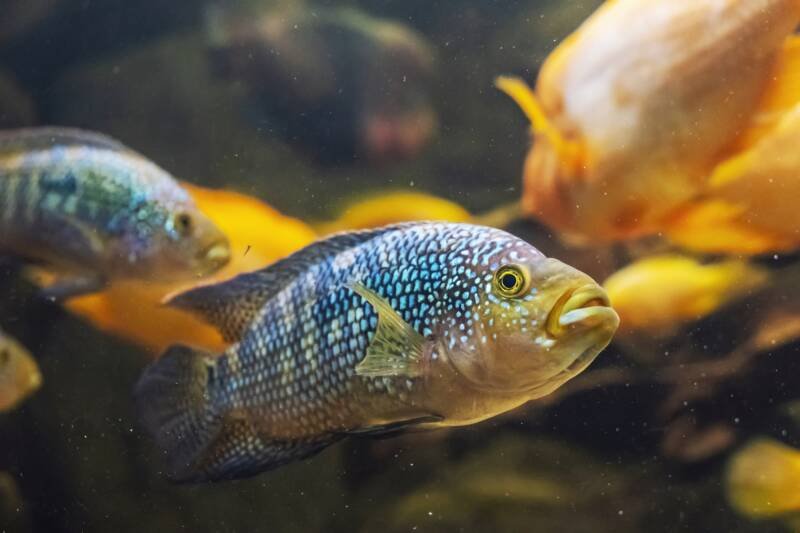
- Difficulty: Easy-Moderate
- Temperament: Semi-Aggressive
- Diet: Carnivore
- Tank Size: 80 gal (303 l)
When you want a spectacular South American cichlid, you look to the Jack Dempsey.
The dark background scales are the perfect setting for the touches of blue, green, and gold. Of course, you need to wait for the fish to mature before those colors come in.
Jack Dempsey’s earned their name from a boxer with a fearsome reputation. And they have the same aggressive tendencies. The older they get, the grouchier they become.
And since they’re one of the larger New World cichlids, that gets tricky to deal with.
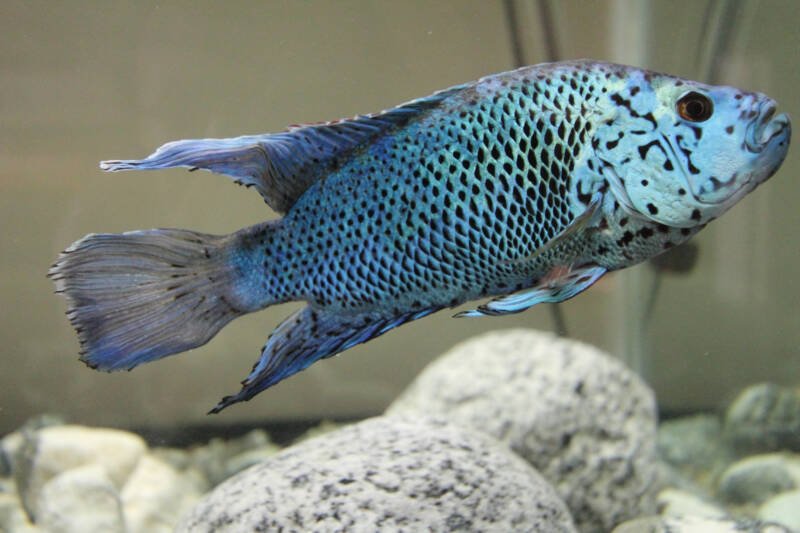
You’ll likely find yourself keeping a single Jack Dempsey in a tank.
And you’ll probably have to resign yourself to frequent “renovations” by your fish.
They love excavating in the sand. Plants that don’t get adequately anchored will quickly end up destroyed.
15. Keyhole cichlid (Cleithracara maronii)

- Difficulty: Easy
- Temperament: Peaceful
- Diet: Carnivore
- Tank Size: 20 gal (76 l)
Keyhole cichlids don’t command attention with bright colors or flashy patterns.
They have a single dark stripe through the eyes, with a black spot further down the body that resembles a (you guessed it) keyhole.
On the shy side for cichlids, keyholes use their muted coloring for camouflage.
When startled by a predator, they huddle against foliage near the substrate. And since they AREN’T aggressive, you can (and should) keep them in schools of 6-8.
While not as popular as some of the other cichlid species, keyholes make agreeable additions to communities.
They’re peaceful, and they fit in nicely with other fish from the Orinoco River basins. If you want a calmer cichlid, you couldn’t do better.
16. Red Parrot Cichlid/Blood Parrot Cichlid

- Difficulty: Moderate
- Temperament: Peaceful
- Diet: Omnivore
- Tank Size: 30 gal (113 l)
If you want controversy, you can’t go wrong with a red parrot cichlid. Like the flowerhorn, this cichlid is an artificial hybrid.
It came about from crossing a Midas cichlid and a red-head cichlid (placing this species on the Central American cichlid list).
Unfortunately, red parrots don’t have excellent adaptations. Their mouths are tiny and deformed, so the lips stay open most of the time. They DON’T eat well.
And they often suffer from deformities of the spine and swim bladder disease, making it difficult for them to swim.
Some fish stores refuse to sell red parrots because of genetic problems. Others, unfortunately, use dyes to achieve those bright colors. This further cuts down on the fish’s lifespan.
If you decide to bring a red parrot home, make sure you prepare for its care needs.
17. Red devil cichlid (Amphilophus labiatus)
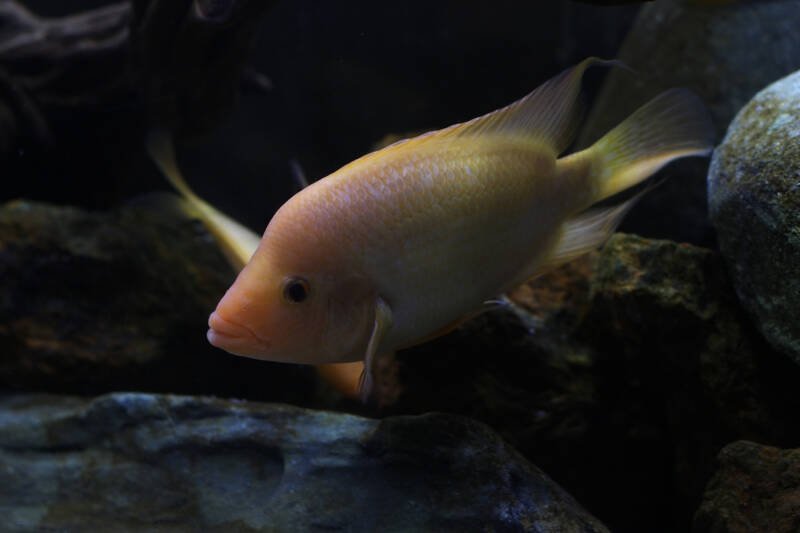
- Difficulty: Difficult
- Temperament: Aggressive
- Diet: Omnivore
- Tank Size: 55 gal (208 l)
In Lake Nicaragua in Central America, red devil cichlids stay close to natural rock caves and submerged logs.
There, they often find themselves on the menu of the bull shark. But in freshwater aquariums? Red devils turn into toothy, fearsome predators.
Aquarists need to place equipment carefully when they take on a red devil cichlid.
The fish have STRONG jaws with razor-sharp teeth. Many red devils have destroyed heaters and filters. Other fish have shattered tank glass by ramming the sides. And some have even bitten their owners!
But red devils also develop bonds with their owners (when they calm that aggression a bit).
To get the food they want, they’ll perform “tricks” to gain attention.
And they follow people from within the confines of the tank. Just make sure you prepare for these devilish monsters!
18. Jaguar cichlid/Managuense cichlid (Parachromis managuensis)

- Difficulty: Moderate
- Temperament: Semi-Aggressive
- Diet: Carnivore
- Tank Size: 100 gal (378 l)
Even as juveniles, jaguar cichlids are impressive to look at. Dark bands stretch across the fish.
And as they get older, the bands break apart into beautiful spots that resemble the jungle cats for which they’re named, all on a silvery-gold background.
Jaguars are top predators in the aquatic realm. They hunt down every fish and invertebrate they encounter without a second thought.
And their jaws extend almost the full extent of their mouth! You’ll definitely want to observe feeding time.
But that predatory instinct – and cichlid nature – makes them less than ideal for community tanks. They have no problem hunting anything else you try to stock.
However, if you buy a bonded pair, you CAN keep them together. As long as your tank’s large enough.
19. Pike Cichlid (Crenicichla lenticulate)

- Difficulty: Difficult
- Temperament: Aggressive
- Diet: Carnivore, with a preference for fish
- Tank Size: 90 gal (341 l) for single, 40 gal (151 l) for each additional fish
Similar in appearance to the game fish with the same name, the pike cichlid is a species not often seen in home aquariums.
One of the challenges to keeping pike cichlids is their size.
These 15-inch (38 cm) tough guys need significant tank space and attention to breaking up the line of sight to decrease aggression.
Another challenge with the pike cichlid is pairing it with other tank mates.
This large fish is a natural predator and an active hunter.
Any smaller tank mates, slower swimming, or peaceful in nature are at risk, and any community pairing should be monitored.
Otherwise, keep these fish in a single species tank with a single male.
20. Texas Cichlid/Rio Grande Cichlid (Herichthys cyanoguttatus)
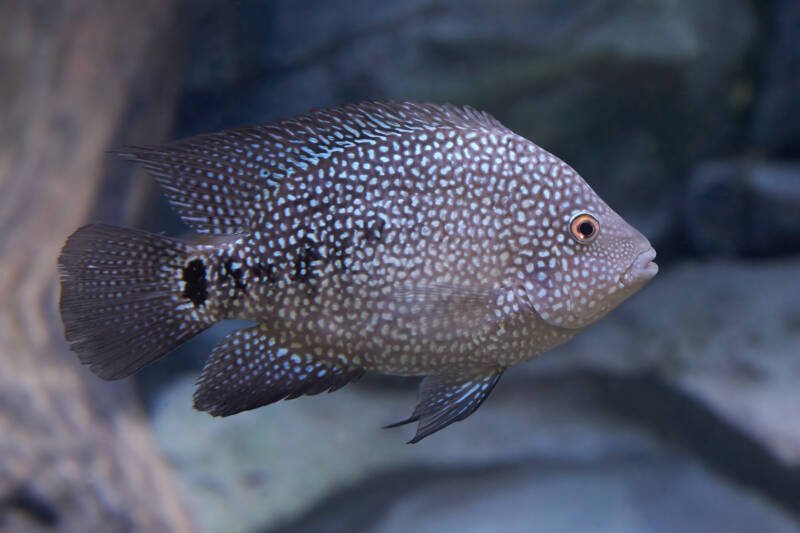
- Difficulty: Moderate
- Temperament: Aggressive
- Diet: Omnivore
- Tank Size: 55 gal (208 l)
Texas cichlids are the only member of the group from North America. They inhabit lakes in rivers in (yes) Texas and northern Mexico.
Unfortunately, they’ve also found their way released into the wild, so they’re now fished for food and sport.
The pearlescent speckles make these cichlids popular choices for aquarists. It adds a shine to the multiple black spots that follow the lateral line.
And as long as you don’t give in to their begging behaviors (which cause obesity), they remain trim and sleek.
But Texas cichlids tip the aggressive scales. They’ll KILL any other fish you attempt to keep in the tank. And that goes double for another Texas cichlid.
You can TRY to put a pair together, but you’ll need MASSIVE amounts of space. It may not be worth the risk.
21. Electric Blue Acara/Blue Acara (Andinoacara pulcher)
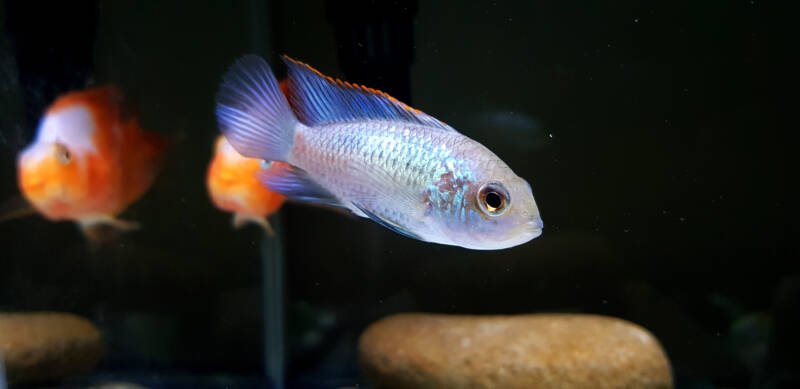
- Difficulty: Easy
- Temperament: Non-aggressive
- Diet: Omnivore, with a preference for meat
- Tank Size: 30 gal (113 l) for single
Looking for a peaceful cichlid with stunning looks? If so, the electric blue acara is a top choice.
Add in that they are fairly undemanding and get along with others in a community tank, and you have the perfect pet.
They reach between six to seven inches (15 to 18 cm) in length, are curious, and love to dig.
Pair them with similarly-sized, peaceful species and anchor any tank decorations for the best result.
These fish are attentive parents that readily breed in an aquarium setting.
Their caring nature makes them a touch territorial when they are breeding. They will chase off any intruders but are amenable at other times.
22. Green Terror Cichlid (Andinoacara rivulatus)
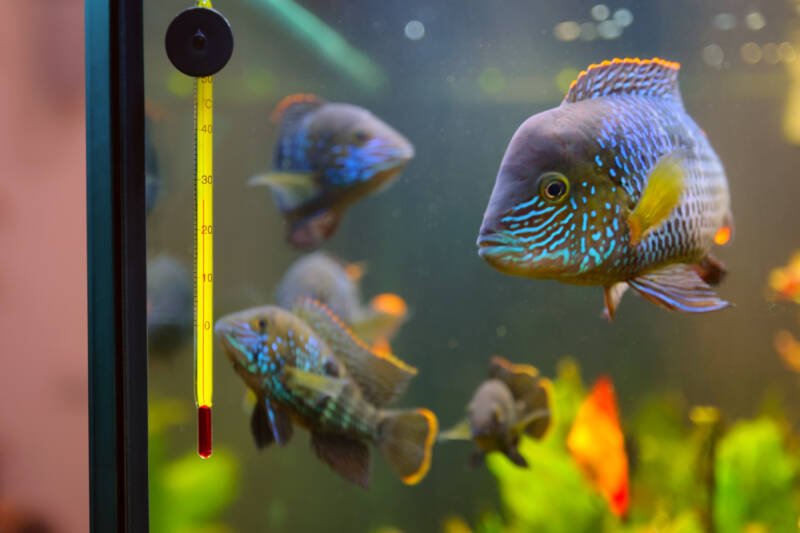
- Difficulty: Easy-Moderate
- Temperament: Aggressive
- Diet: Omnivore
- Tank Size: 50 gal (189 l) for one; 75 gal (284 l) for a pair
When aquarists think of aggression in New World cichlids, green terrors come to mind. (They don’t have “terror” in their name for nothing!)
These colorful members of the group come from the tropical river basins of Peru and Ecuador, and they’re as lethal as they are beautiful.
Setting up territories within your tank, green terror cichlids patrol their home and chase any fish beyond the boundaries.
Smaller tank mates end up a part of the menu (and it doesn’t matter if they’re fish or invertebrates).
And if the fish happen to match in size? They STILL get harassed.
Spawning season is the worst. Both parents watch over and guard their nest and fry. Any fish that comes close will end up viciously attacked.
You’ll want to set up a separate breeding tank to prevent genuine terror from breaking out.
23. Black Ram Cichlid/Midnight Ram (Mikrogeophagus ramirezi)
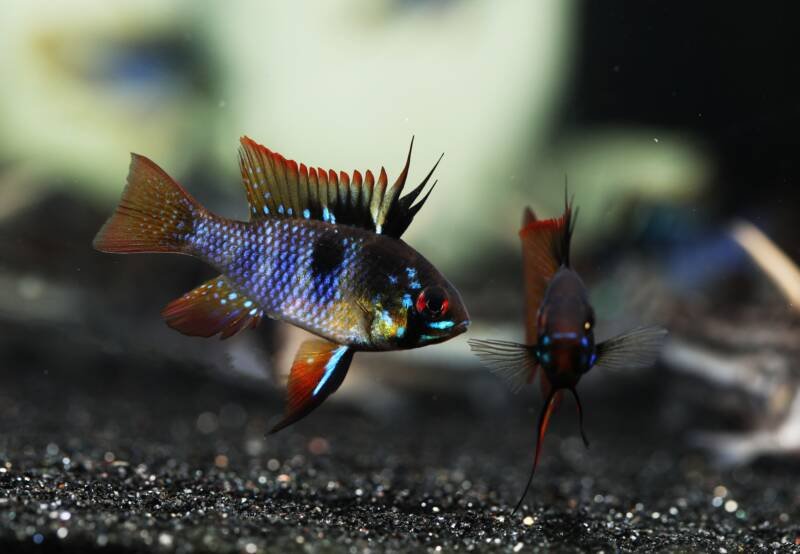
- Difficulty: Easy
- Temperament: Non-aggressive
- Diet: Omnivore
- Tank Size: 20 gal (75 l) for single, 30 gal (114 l) for a pair
The dark-colored black ram cichlid is one of several color variations of Mikrogeophagus ramirezi.
This dwarf cichlid is loved for its looks and its smaller size (most specimens will not exceed three inches (8 cm) in length).
Another plus? These fish have a delightfully peaceful nature and can brighten up a community tank with smaller schooling fish.
They will claim a territory and chase away intruders, but this action does not typically result in harm to the other fish.
Unlike its larger cousins, the black ram can live in a tank with larger freshwater shrimp; however, smaller ones will become a meal.
The male of this species is an especially good parent, staying with the fry and teaching them what to eat.
24. Festivum Cichlid (Mesonauta festivus)

- Difficulty: Easy
- Temperament: Non-aggressive
- Diet: Omnivore
- Tank Size: 30 gal (113 l) for single
Festivum cichlids come in six different color variations and bring a gentle splash of color to a community tank.
They are a smaller, curious fish that reaches a manageable four inches (10 cm) in length as an adult.
As with many cichlids, they favor the middle to bottom levels of the tank.
Festivums enjoy swimming among aquatic plants and will thrive in a well-planted tank with peaceful tank mates.
They can be a touch shy and should be kept in a group of at least six to allow them to comfortably explore.
Similarly sized, social fish are the best match for the festivum.
25. Severum Cichlid (Heros severus)

- Difficulty: Easy
- Temperament: Non-aggressive (except when spawning)
- Diet: Omnivore
- Tank Size: 55 gal (208 l) for single, 100 gal (379 l) for a group
Severum cichlids come in several color variations, including blue, green, red, and black. Watch as these beautiful fish grow even more colorful as they age.
At an adult size of eight inches (20 cm), the aquarium size needed for severums is reasonable.
Both beginning and experienced aquarists are drawn to the active behavior and ease of care that come with this fish.
Severums have agreeable personalities that allow them to pair with numerous other species in a community tank.
That said, take care when selecting said tank mates. Severums are opportunistic feeders that can mistake smaller fish for food.
Conversely, larger tank mates may bully the more peaceful severum.
26. Demon Eartheater Cichlid (Satanoperca jurupari)
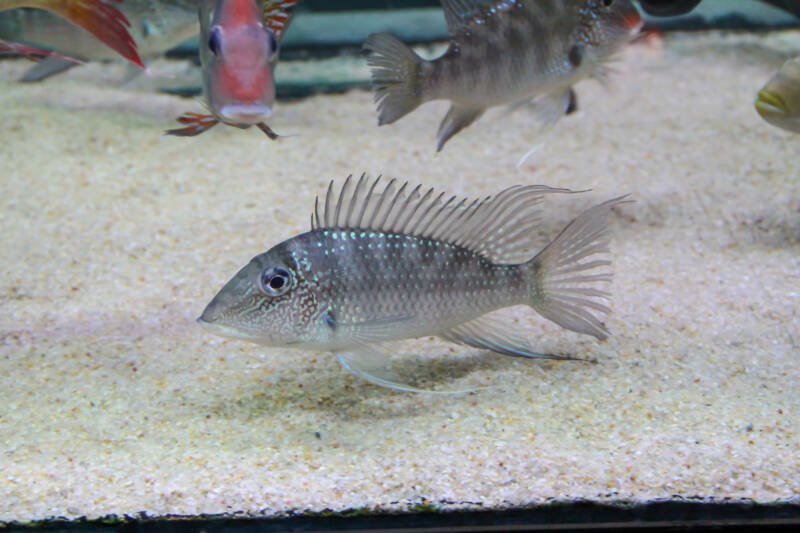
- Difficulty: Easy
- Temperament: Semi-aggressive
- Diet: Omnivore
- Tank Size: 55 gal (208 l) for a single
This stunning fish with the frightening name is actually a fairly mellow South American species.
They are highly curious and grow to a decent, 10-inch (25 cm) size.
Given their size and personality, you can place them in a tank with larger cichlid species.
The “earth eater” portion of their name is not without merit. These fish spend most of their time digging through the sand in search of food.
Keep this in mind if you want live aquatic plants in your tank and consider potted or floating varieties.
This mouthbrooding species likes to reside in groups and will breed in a home aquarium environment.
An excellent parent, the female will care for the young until they are free-swimming.
27. Umbee Cichlid (Kronoheros umbriferus)
- Difficulty: Difficult
- Temperament: Aggressive
- Diet: Carnivore
- Tank Size: 150 gal (568 l) for single, over 300 gal (1,136 l) if including other fish
If you want to go all out on cichlid size, then consider the umbee cichlid.
These monsters reach an incredible 24 inches (61 cm) in length for males and around 18 inches (46 cm) for females.
They are a fast-growing species that reach their full size in around two years.
Juvenile coloration is drab but morphs into a lovely blue as they mature.
Selecting tank mates for the umbee is challenging. Consider keeping these aggressive predators as a single specimen.
They form mated pairs for life, so keeping a pair is possible as well.
Multiple males, however, should not be kept together. If you decide to place them in a community tank, select large fish with some aggression.
28. Rainbow Cichlid (Archocentrus multispinosus)
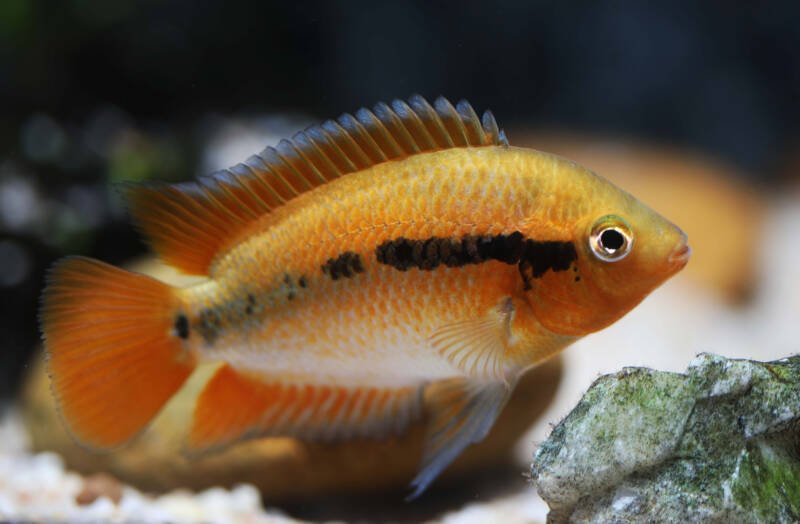
- Difficulty: Easy
- Temperament: Non-aggressive
- Diet: Omnivore
- Tank Size: 30 gal (113 l) for single
The mood ring of cichlids, the rainbow is named for its ability to shift its coloration in response to its mood.
They stay on the smaller side, only reaching between three to 6.5 inches (7.6 to 16.5 cm) in length, which makes tank size reasonable.
These energetic, social fish do best in a group of six or more to allow schooling behavior.
Their tank should include plenty of swimming space, or they can become stressed.
Due to their peaceful nature, rainbow cichlids make excellent community tank members if paired with fish of similar temperament, including barbs, tetras, and other gentle cichlids.
29. Uaru Cichlid (Uaru amphiacanthoides)
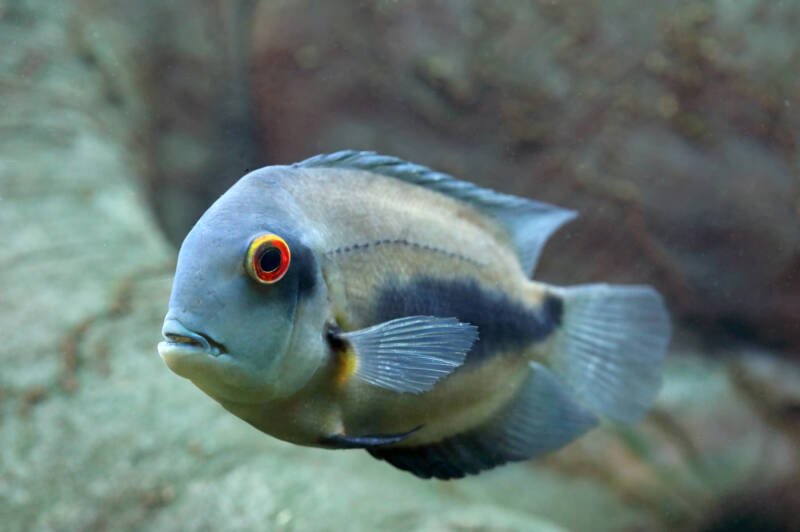
- Difficulty: Easy
- Temperament: Semi-aggressive
- Diet: Omnivore, but favors vegetables
- Tank Size: 55 gal (208 l) for single, 130 gal (500 l) for a group of four
Uaru cichlids come in a range of colors and sport striking black markings on their oval-shaped bodies.
They need a decent-sized tank as they reach an adult length of 10 inches (25 cm).
Although they are not social fish, uaru cichlids prefer to be with several of their own kind.
Keep them in pairs with other Central or South American fish. Uarus are peaceful but highly territorial when spawning.
In the wild, this Amazonian species lives in waters lush with vegetation, so plan to include some live plants in your aquarium.
Be aware that the uaru needs warmer water than most cichlids. Any tank mates should thrive under these same conditions.
30. Cuban Cichlid (Nandopsis tetracanthus)
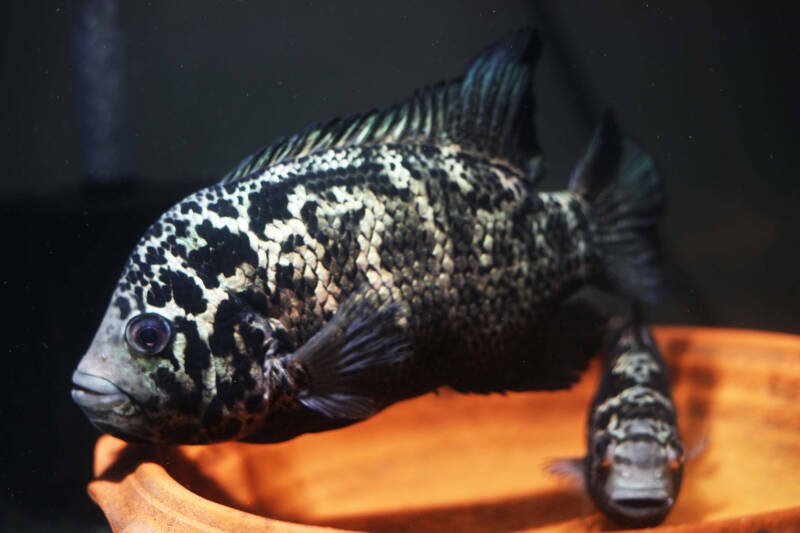
- Difficulty: Moderate
- Temperament: Aggressive
- Diet: Omnivore
- Tank Size: 55 gal (208 l) for a single, 100 gal (379 l) for a pair
Cuban cichlids have a spectacular silver and black pattern covering the body and extending into their fins.
This 10-inch-long fish (25 cm) is a freshwater species from the island of Cuba.
They are considered an aggressive species; however, this is one where the individual personality of the fish may play a role in how well it gets along with others.
They should live as a single specimen or in pairs, and any community tank should have similarly sized fish.
If you are interested in breeding Cuban cichlids, raise a young group of them together, and they will naturally pair up.
These fish are protective parents that will watch over their fry until they spawn again.
31. Midas Cichlid (Amphilophus citrinellus)
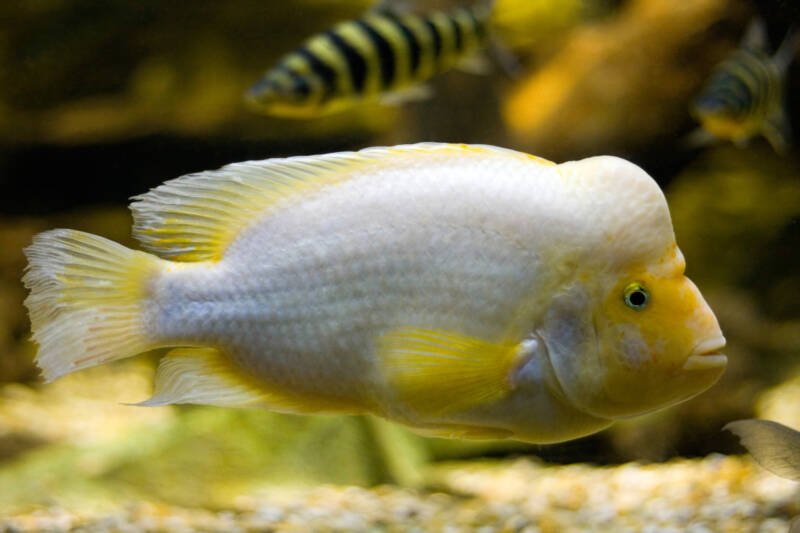
- Difficulty: Moderate
- Temperament: Aggressive
- Diet: Omnivore
- Tank Size: 55 gal (208 l) for single, 125 gal (473 l) for a pair; tank at least 6 feet long
The popular Midas cichlid is a sizable fish, reaching from 10 to 14 inches (25 to 36 cm) in length.
They come in a range of color varieties and can live up to 12 years. These fish love to dig and can easily uproot or shred any live plants.
These fish hail from Central America and tend to be on the peaceful side of the cichlid behavior spectrum; however, they can develop aggressive habits if kept in an aquarium that is undersized.
In the wild, they vigorously defend a sizable area surrounding their nests during their breeding cycle.
This area can extend up to four feet (123 cm) around their breeding site, necessitating an equally sizable tank.
32. Vieja Cichlid (genus)
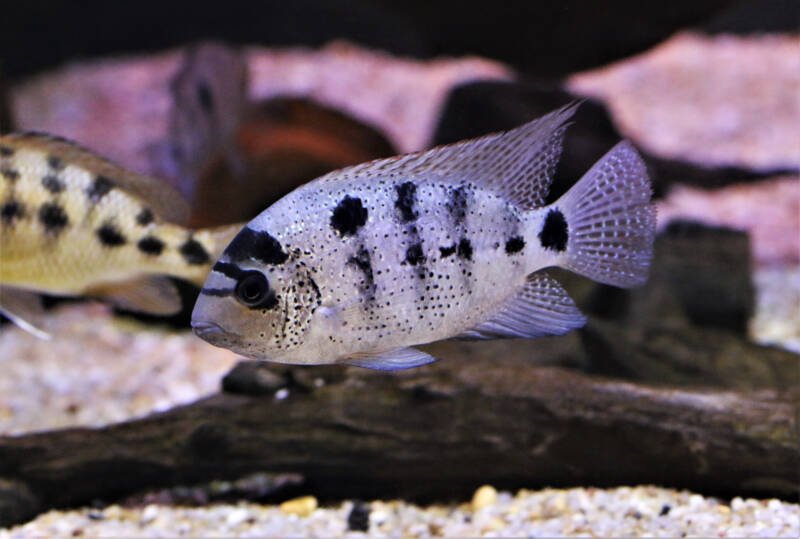
- Difficulty: Moderate to Difficult
- Temperament: Non-aggressive to aggressive, depending on the species
- Diet: Omnivore, with a heavy emphasis on vegetation
- Tank Size: up to 155 gal (587 l) for single, 250 gal (946 l) for a community
Vieja cichlids are a genus of sturdy fish from Central and South America.
The eight species in the genus include the black belt cichlid mentioned above.
These fish favor slow-moving waters and a primarily plant-based diet, although they will eat invertebrates or smaller fish.
Some of the species, such as the redhead cichlid (Vieja synspila), can grow to a large size of 16 inches (41 cm). Therefore, large aquariums are a must.
Temperaments can range from the amenable redhead to the feisty silver cichlid (Vieja argentea).
With a big tank that is arranged to allow the fish to claim territories, most of these species can be kept with other fish of similar size.
33. Black Belt Cichlid (Vieja maculicauda)

- Difficulty: Moderate
- Temperament: Aggressive
- Diet: Omnivore, with a heavy emphasis on vegetation
- Tank Size: 55 gal (208 l) for single
This cichlid prefers the slower moving waters of streams and lakes that are heavily vegetated.
In its natural habitat, this hardy fish can tolerate both fresh and slightly brackish water.
They grow to 10 inches (25 cm) in length and need a good-sized tank.
The black belt title also reflects this fish’s tough personality. They are fairly aggressive, especially if there are any fry in the picture.
Although black belts are primarily herbivores, they will just as quickly go after any smaller fish in the aquarium as a snack.
Keep them singly or in pairs with similarly sized Central or South American fish.
34. Black Nasty Cichlid (Nandopsis haitiensis)
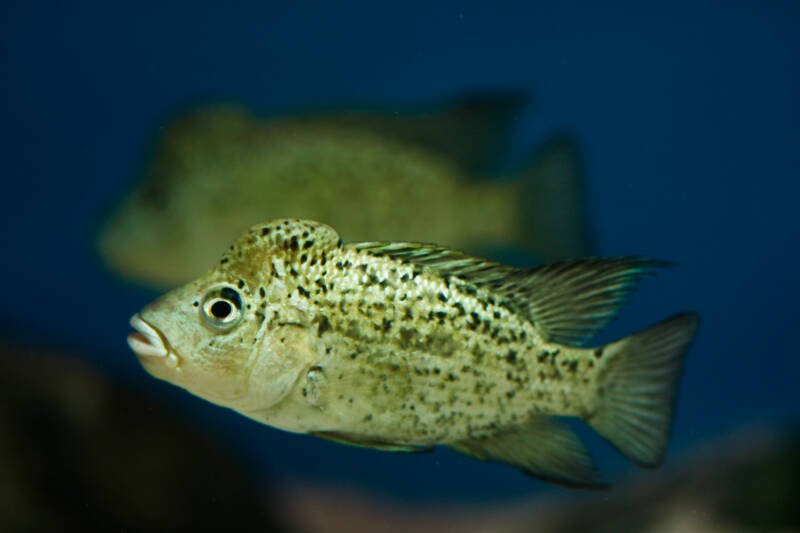
- Difficulty: Difficult
- Temperament: Aggressive
- Diet: Omnivore
- Tank Size: 75 gal (284 l) for single
The black nasty cichlid is closely related to the Cuban cichlid. You will also see it marketed as the Haitian cichlid or odo cichlid.
It favors the lakes and fast-water streams of Haiti and reaches an adult size of 15 inches (38 cm).
By its name alone, you may guess the temperament of this fish.
They are considered one of the more aggressive cichlid species and should be kept as a single specimen or in a community of other large, equally aggressive fish.
Be aware that even in a large, well-designed tank, the strength and aggression of this fish can overpower larger tank mates.
35. Carpintis Cichlid (Herichthys carpintis)

- Difficulty: Easy
- Temperament: Semi-aggressive
- Diet: Omnivore
- Tank Size: 55 gal (208 l) for a single, 75 gal (284 l) for a pair
Caprintis cichlids, also known as pearlscale cichlids, are native to the waters of northern Mexico.
You will find them in slow-moving drainage areas that are rich in plant life.
They have boisterous personalities, reach a sizable length of 12 inches (30 cm) as adults, and are habitual diggers, so secure live aquatic plants accordingly.
They get along with others in a community tank, except when spawning.
During these times, the breeding couple becomes territorial, and occasionally, the male can become aggressive toward the female.
This fish is often mistaken for the true Texas cichlid (Herichthys cyanoguttatum).
Do not keep these two species together as they can interbreed.
36. Salvini Cichlid (Cichlasoma salvini)
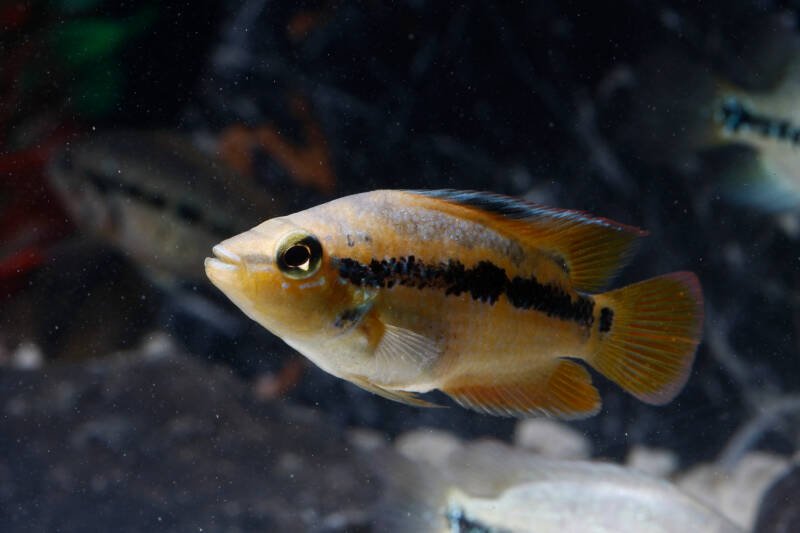
- Difficulty: Moderate
- Temperament: Aggressive
- Diet: Omnivore
- Tank Size: 40 gal (151 l) for single, 100 gal (379 l) for a pair
Another fish that changes color throughout its lifespan, the adult Salvini sports a bright yellow look that intensifies during breeding periods.
Reaching an adult length of around 8.5 inches (22 cm), they are manageable as a single specimen in a moderately sized home aquarium.
Because they are highly territorial, these cichlids are best kept in a single species tank.
If you keep more than one Salvini, plan on more than doubling the tank size to minimize aggression.
These fish are especially messy eaters, so strict adherence to maintaining tank cleanliness is a must.
Live aquatic plants can help keep up the water quality, and Salvini are thankfully not too rough on them.
37. Moga Cichlid (Hypsophrys nicaraguensis)
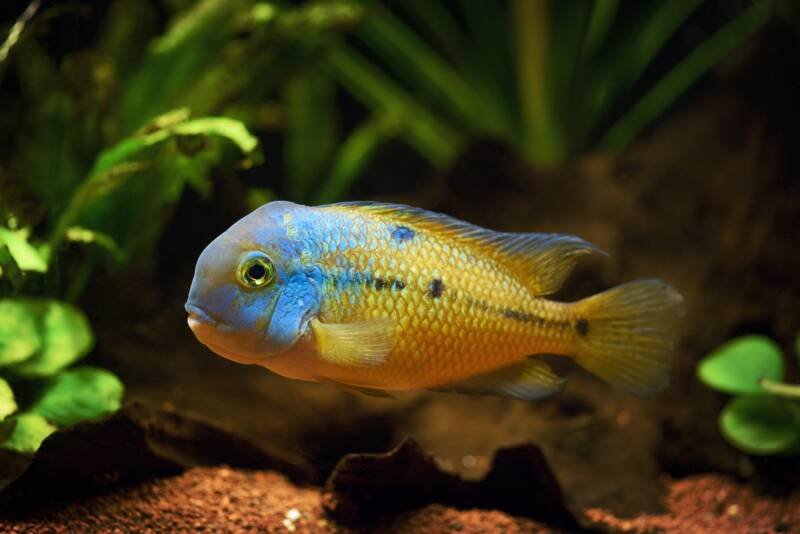
- Difficulty: Moderate
- Temperament: Aggressive
- Diet: Omnivore
- Tank Size: 65 gal (246 l) for single male or a pair, 6-foot length if kept with other cichlids
Moga cichlids have colorful bodies with a bold black stripe running the length.
This species is one of the more peaceful cichlids and grows to a large size of 10 inches (25 cm), with the females slightly smaller.
Plan on a large tank with multiple caves to allow them to shelter as needed.
This species is best kept as a single specimen or a mated pair.
If kept in a community tank, increase the tank size significantly and do not pair your moga with highly aggressive species.
Even a mated pair can even be aggressive toward each other and can benefit from having a school of dither fish in the tank.
38. Pink Convict Cichlid (Archocentrus nigrofasciatus)

- Difficulty: Easy
- Temperament: Aggressive
- Diet: Omnivore
- Tank Size: 30 gal (113 l) for single, 55 gal (208 l) for a pair
As far as cichlids go, the pink convict is a great choice for a beginning aquarist. They are easy in terms of care and feeding.
The female of this semi-albino-colored fish displays gold scales on her body during breeding, and the male develops a nuchal hump as he matures.
The biggest challenge with pink convicts comes when pairing these fish in a community tank.
Although they grow to a small size between three to five inches (8 to 13 cm) in length, they are highly aggressive and extremely territorial.
Any fish you pair with them should be the same size or larger and kept in a spacious tank.
Pink cichlids form monogamous pairs. Keeping them as a single specimen or a paired couple is best.
39. Red Terror Cichlid (Cichlasoma festae)
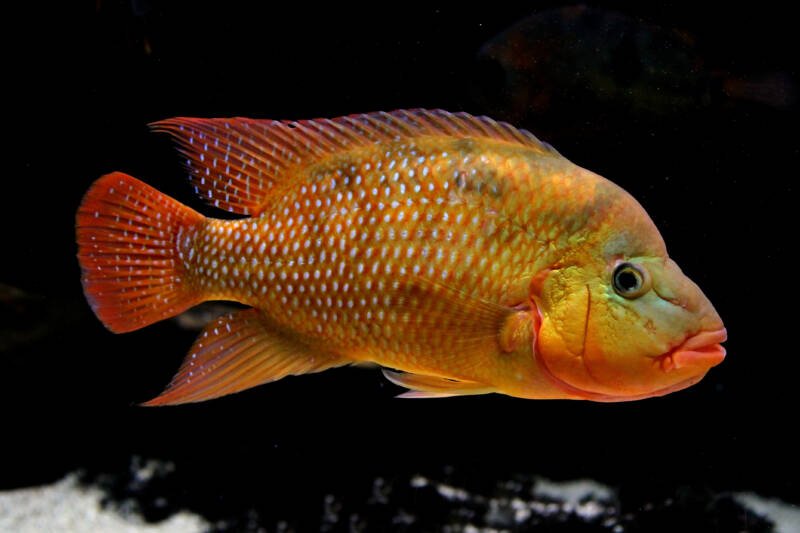
- Difficulty: Moderate
- Temperament: Aggressive
- Diet: Omnivore
- Tank Size: 180 gal (681 l) for single, 7 feet (2 meters) in length for a pair
Female red terror cichlids are a vibrant color. The males, while not quite as colorful, grow to a large size of 20 inches (51 cm).
The smaller, 12-inch (30 cm) females can nevertheless hold their own against the larger males.
These territorial fish do not school well, and large groups in a tank can lead to increased aggression.
Stick with a smaller group of two to three fish, which can coexist in a sizable tank.
Both sexes look the same when they are young, so if you are looking to breed (or not), wait until they are between four to five inches in length (10 to 13 cm), when they are just shy of a year old.
At this point, you will begin to see dimorphism and can select the appropriate sex for your tank.
40. Chocolate Cichlid/Emerald Cichlid (Hypselecara temporalis)

- Difficulty: Moderate
- Temperament: Non-aggressive
- Diet: Omnivore
- Tank Size: 75 gal (284 l) for single
The chocolate cichlid, also called the emerald cichlid, is a gentle giant of a fish, reaching an adult length of up to 12 inches (30 cm).
They love slow-moving, warm, soft water with plenty of sand in which to dig.
Keep that digging behavior in mind when selecting and securing tank decorations.
Because they are big omnivores, avoid placing them in a tank with smaller fish that may be mistaken for food.
Otherwise, increase the tank size, and your chocolate cichlid can live with any number of large, peaceful species.
Whether in a species-specific tank or a community, keep chocolate cichlids as a single specimen or a pair. Larger groups may become aggressive toward each other.
41. Wolf Cichlid/Dovii Cichlid (Parachromis dovii)
- Difficulty: Moderate
- Temperament: Aggressive
- Diet: Carnivore
- Tank Size: 120 gal (454 l)
The wolf cichlid is a large, Central American species that grows to a length of 28 inches (71 cm).
They are long-lived fish that will survive up to 30 years if well cared for.
It can be difficult to place this fish in a community tank both due to its size and its prowess as a hunter.
These carnivores will view smaller fish as ready prey and can even turn on similarly sized tank mates.
Keeping a mated pair is an option, but be aware that even in these cases, the male can become aggressive toward the female.
Keep them in a large tank with multiple hiding places.
42. Trimac Cichlid/Three Spot Cichlid (Cichlasoma trimaculatum)
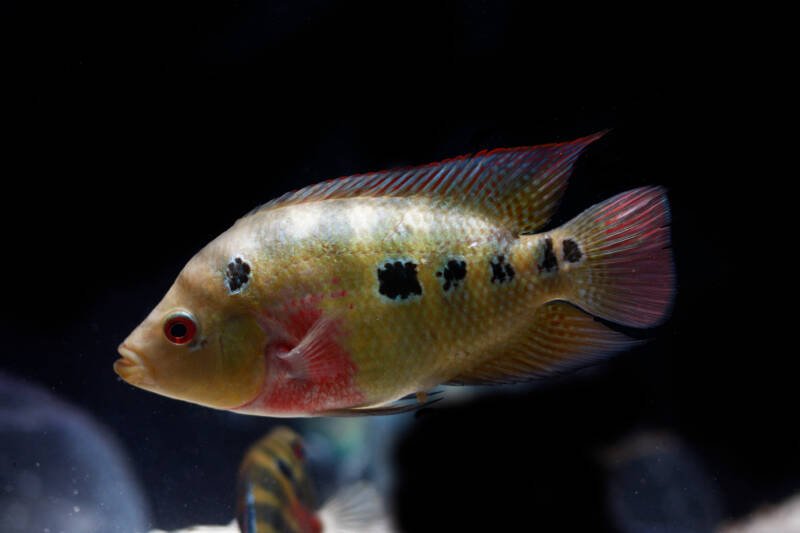
- Difficulty: Moderate
- Temperament: Aggressive
- Diet: Omnivore
- Tank Size: 75 gal (284 l)
In the wild, you will find the trimac cichlid, also known as the three-spot cichlid, happily cruising the muddy, vegetation-heavy waters of coastal plains.
In captivity, these robust, 14-inch (36 cm) fish tend to rearrange their tank, so anchor items securely.
Trimac cichlids are aggressive predators that will claim a territory as their own and guard it well.
Keep them in a single species tank or plan on a large habitat decorated to break up the line of sight.
Aggression can get even higher when breeding. During these times, remove the pair to a dedicated breeding tank.
These protective parents will jealously guard their offspring and can injure intruders to their territory.
43. T-bar Cichlid (Cryptoheros sajica)
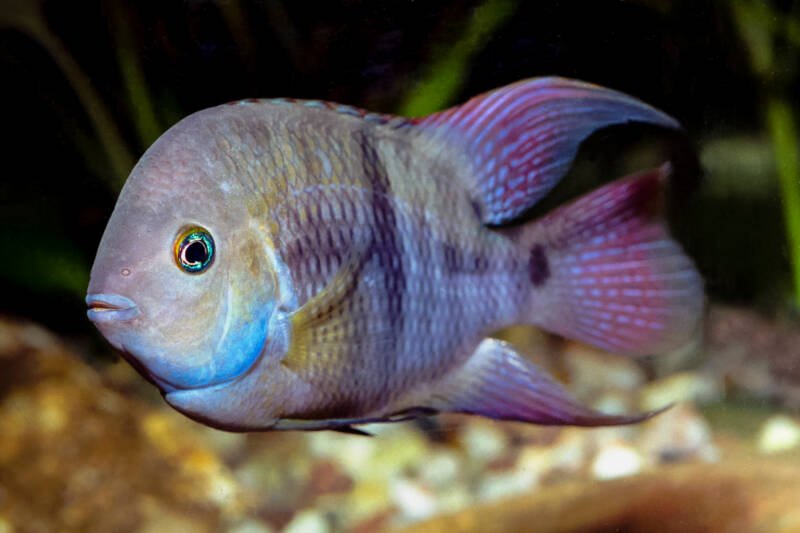
- Difficulty: Easy
- Temperament: Non-aggressive
- Diet: Omnivore
- Tank Size: 40 gal (151 l) for pair
Finally, we come to the t-bar cichlid. These gold-colored fish have vertical black stripes and strikingly blue eyes.
They do not tear up aquatic plants as do other cichlid species and are undemanding in their feeding needs.
Smaller in size and peaceful in nature, this Central American species makes a comfortable addition to community tanks.
It can even be placed with larger, more aggressive species.
Although it only measures five inches (13 cm) fully grown, it is more than able to fend off a tank bully.
They readily spawn in an aquarium setting and can become highly territorial when doing so. Keep them alone as a mated pair or increase the tank size if they are in a community tank.
Cichlid Tank Setup
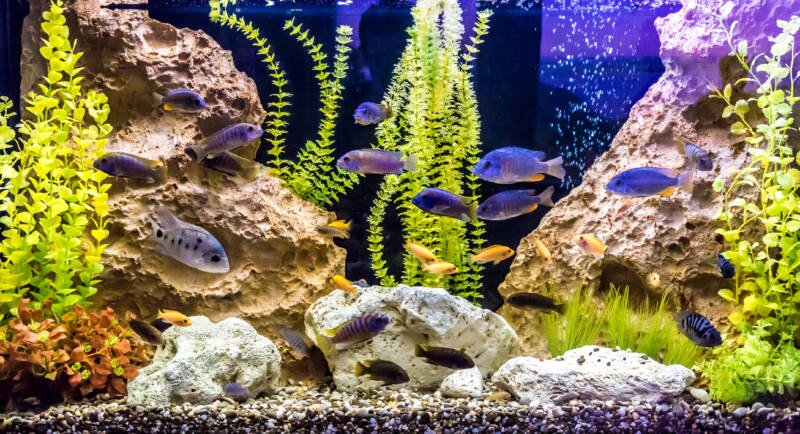
The cichlid you select will dictate your tank size and water conditions.
However, in general, the region you pull your species from will give you a rough idea. Always verify your species’ needs before introducing them to your aquarium.
| Parameter | African Cichlids | New World Cichlids |
| Water Temperature: | 75-85°F (24-29°C) | 76-83°F (24-28°C) |
| pH: | 7.8-8.6 | 6.0-7.5 |
| Water Hardness: | 4-6 dKH | 1-4 dKH |
| Nitrite: | 0 ppm | 0 ppm |
| Ammonia: | 0 ppm | 0 ppm |
| Nitrate: | < 40 ppm | < 40 ppm |
Cichlids appreciate water flow in their tanks.
Your filter’s outflow should do the trick, but if you pick a species native to a river region, consider adding an air pump for a little more current. (The added oxygen won’t hurt, either)
Aquarists love the dynamic nature of cichlids. These fish zoom around tanks (in addition to rooting around decorations).
They also jump, so make sure you have a cover on your tank. Otherwise, you could find that new acquisition on the floor. (Not ideal – for you or them)
Cichlid Breeding
Even peaceful species get territorial during the breeding season. If you have weaker fish – even if they’re the same size – they may get harassed or even attacked.
Providing caves for hiding and plenty of territory for your cichlid will help diffuse the tension.
All cichlids lay eggs, though care varies among species.
Some guard their eggs in caves, while others mouthbrood. This means they keep the fertilized eggs in their mouth for 21 days before hatching.
Females watch the fry for about two weeks, and then they’re on their own.
Hardiness and Diseases
Overall, these hardy fish do well in aquariums.
So long as you stay on top of water quality and don’t fall prey to their begging habits (yes, they’re cute when they follow you around – don’t succumb to overfeeding), your cichlids should avoid significant health issues.
Common fish illnesses to watch for include:
- Cotton Wool Disease: Poor water conditions prompt this fungal disease, resulting in white growths.
- Gill Flukes: Flukes are parasites. These particular flukes coat the gills in slime, interfering with your cichlid’s breathing.
- Hexamita: Another parasite brought on by poor water quality. Fish develop lesions, and their appetites drop off.
- Ich: This parasite is the bane of aquarists. You know the stereotypical white spots.
- Malawi Bloat: Common to African cichlids, this disease causes abdominal swelling, resulting in kidney and liver issues.
- Swim Bladder Disease: Poor nutrition or physical injury from tank mates leads to your fish losing the ability to remain submerged.
- Tuberculosis: You DON’T want to see this in your tank; it’s not only fatal, but it’s also HIGHLY CONTAGIOUS. You identify this nasty disease by loss of appetite and white blotches on the scales.
Unhappily, you can’t mix African and New World cichlids!
The two groups split thousands of years ago, evolving different immune systems. Combining species from the two regions WILL result in a health disaster.
The Greater the Variety, the Greater the Reward
Cichlids provide something for everyone. Whether you’re interested in a particular color, shape, pattern, or even breeding style, there’s a cichlid for you.
Just make sure you monitor water quality carefully to prevent disease or stress.
Do you have a favorite cichlid? Have you tackled the difficult discus?
Share your story here!